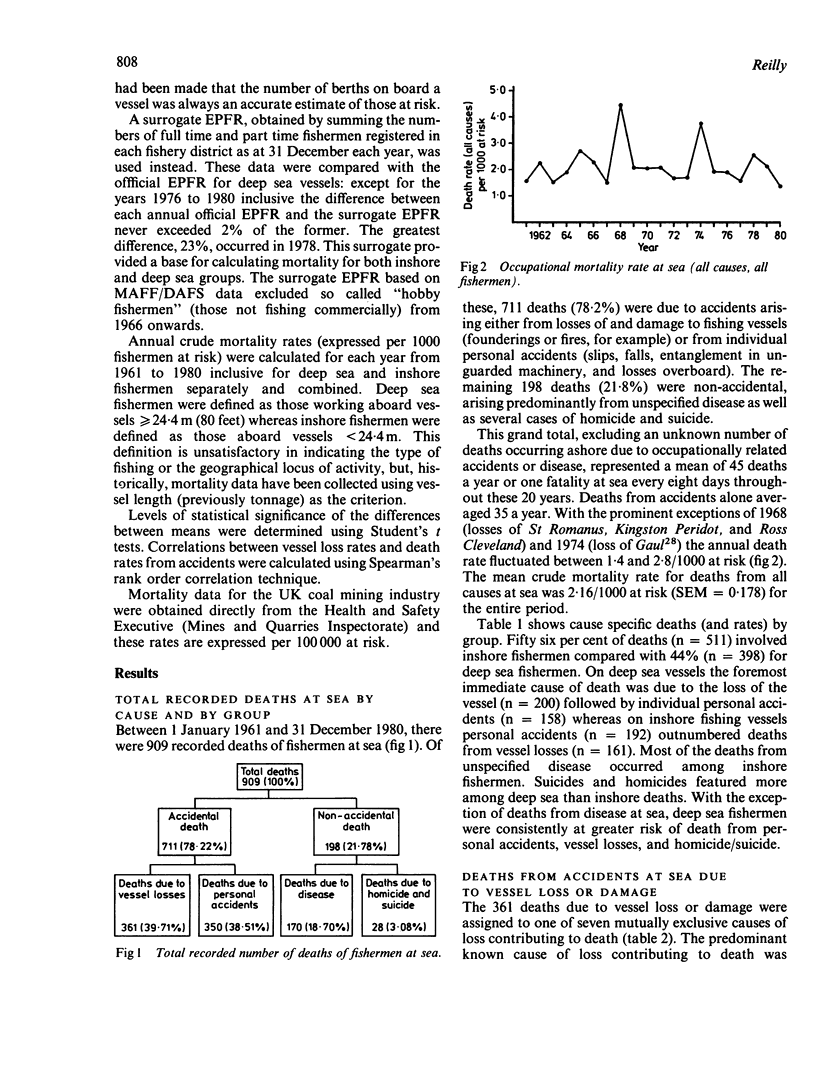Abstract
After the catastrophic losses of three Hull deep sea trawlers in 1968, the Committee of Inquiry into Trawler Safety (CITS) was established. Fourteen months later, CITS reported on factors affecting the safety of deep sea trawlers and their crews. Pre-CITS (1961-70) and post-CITS (1971-80) crude mortality rates for accidents at work are compared for "deep sea" fishermen (those working on vessels greater than or equal to 24.4 m (80 feet) registered length) and "inshore" fishermen (those working on vessels less than 24.4 m). The ratio of deep sea to inshore fishermen had changed from 1:1.5 (1961) to 1:7.0 (1980), reflecting the radical restructuring of the fishing fleet that began in the early 1970s. Between 1961 and 1980, there were 909 recorded deaths at sea of United Kingdom fishermen. Of these, 711 (78%) were due to accidents (either from vessel losses or personal accidents) and 198 (22%) were due to unspecified disease, homicide, and suicide. Comparison of pre-CITS and post-CITS mean death rates showed an increase (+39%) for deep sea fishermen, a decrease (-4%) for inshore fisherman, and an increase (+2%) for both combined. For deep sea fishermen, there were synchronous increases in mortality from vessel losses (+32%) and from personal accidents (+49%, p less than 0.05) whereas the overall rate for inshore fishermen reflected a decrease (-33%, p less than 0.01) in deaths from personal accidents but an increase (+52%) in deaths from vessel losses. Although pre-CITS mortality rates exhibited no statistically significant difference between deep sea fisherman was significantly greater (p< 0.02). Compared with coal miners, fishermen were, on average, four times more likely to die from accidents at work. If CITS had reasonable cause for concern in 1969, the grounds for similar concern did not diminish because the evidence suggests that deep sea fishermen were at no lesser risk of death from accidents after CITS reported than before. Overall, both groups of fishermen experienced an accident mortality rate between 1961 and 1980 that showed no indication of improvement.
Full text
PDF








Selected References
These references are in PubMed. This may not be the complete list of references from this article.
- Cadenhead R. Hospital admissions of fishermen from the fishing grounds around the Shetland Islands. J Soc Occup Med. 1976 Oct;26(4):127–131. doi: 10.1093/occmed/26.4.127. [DOI] [PubMed] [Google Scholar]
- Ellis F. P. Medical aspects of trawler safety. Br J Ind Med. 1970 Jan;27(1):78–81. doi: 10.1136/oem.27.1.78. [DOI] [PMC free article] [PubMed] [Google Scholar]
- Frank C. D., Golden C. Hypothermia: a problem for North Sea industries. J Soc Occup Med. 1976 Jul;26(3):85–88. doi: 10.1093/occmed/26.3.85. [DOI] [PubMed] [Google Scholar]
- Moore S. R. The mortality and morbidity of deep sea fishermen sailing from Grimsby in one year. Br J Ind Med. 1969 Jan;26(1):25–46. doi: 10.1136/oem.26.1.25. [DOI] [PMC free article] [PubMed] [Google Scholar]
- Newhouse M. L. Dogger Bank itch: survey of trawlermen. Br Med J. 1966 May 7;1(5496):1142–1145. doi: 10.1136/bmj.1.5496.1142. [DOI] [PMC free article] [PubMed] [Google Scholar]
- Pugh L. G. Isafjordur trawler disaster: medical aspects. Br Med J. 1968 Mar 30;1(5595):826–829. doi: 10.1136/bmj.1.5595.826. [DOI] [PMC free article] [PubMed] [Google Scholar]
- Schilling R. S. Hazards of deep-sea fishing. Br J Ind Med. 1971 Jan;28(1):27–35. [PMC free article] [PubMed] [Google Scholar]
- Schilling R. S. Trawler fishing: an extreme occupation. Proc R Soc Med. 1966 May;59(5):405–410. doi: 10.1177/003591576605900504. [DOI] [PMC free article] [PubMed] [Google Scholar]


